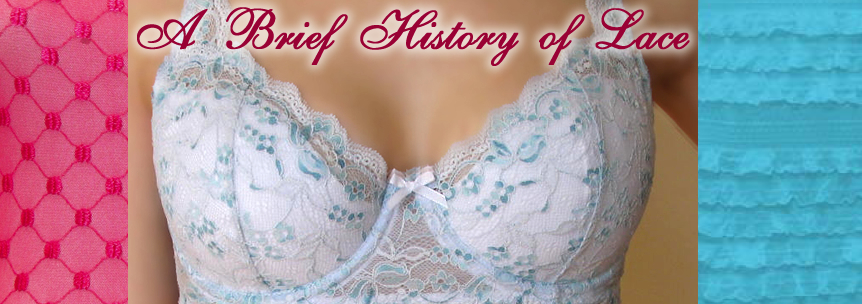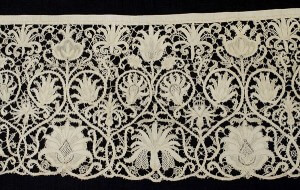We love lace; this special fabric is at once sophisticated, sexy, artistic and supremely feminine. Since its introduction hundreds of years ago, lace has played an important role in fashion, and as a status symbol for the wearer.
Lace is considered to be an openwork fabric, that is, a fabric characterized by containing holes or open spaces in its design. There are many ways to achieve these web-like structures: lace can be made through looping, twisting, braiding or knotting threads together to create delicate patterns. Some styles of laces include Chantilly, Valenciennes, Tatting, Punto in Aria, and Bemberg.
Traditionally, lace has been made by hand, but today there are many lovely machine made laces as well. Depending on the type of lace one thread or hundreds of threads can be combined together. Popular motifs for lace over the centuries has been dependant on the whims of fashion, but florals and paisleys designs seem to be classics that have never gone out of style.
Lace has traditionally been made from fine linens, silks, and even sometimes real gold and silver threads. Today, with our desire for high quality goods at a cheap price, most laces are made from inexpensive cotton, polyester, or a blend of both.
Some scholars believe that the ancient Romans were the first to make lace, but no examples of fabrics or lace making tools have ever been found. We can say with certainty that lace began to be made and worn during the early Renaissance in Europe. Lace probably originated in Flanders and was made for the clergy. The fabric quickly spread throughout Europe, developed along many different regional styles and techniques, and became a high-fashion staple for trimming both men’s and women’s clothing.
In my opinion, lace really bloomed in three historical eras: the Baroque (17th century), the Rococo (18th century), and during the Industrial Revolution (19th century). One has to look no further than the paintings of Peter Paul Reubens from the 1600s to see how important lace was for fashion; collars, cuffs, hats and sometimes even boots would be trimmed with layers of delicate handmade laces. The Baroque era laces would often be starched to give them a stiffness and volume.
Fashions of the Rococo era were much lighter and prettier than the heaviness of the Baroque, but lace continued to play a vital role in dressing. Rococo lace was more delicate, and starching was no longer in vogue. The decadent fashions of the 1700s featured lace collars, cuffs (called engageants), and decorative trimmings. These laces were so valuable that trimmings and engageants were often removable items; this allowed the individual to wear their lace with many different ensembles.
It is worth noting that the laces of the Baroque and Rococo period were all handmade, and outrageously expensive. They were beautiful fabrics, but really served as a status symbol; the more lace you wore, the richer you were. Unfortunately, lace was often made by poor women who were forced to sit in damp dark candle lit basements (moisture helped the threads from breaking). Many of these craftswomen developed serious heath problems, or went blind from making lace for the elite in society.
With the Industrial Revolution in full swing by the early 19th century, lace making underwent a dramatic change. For the first time, it was possible to make machine-made laces that imitated the look of the handmade styles at a fraction of the price. Lace became a democratic fabric, that all members of society could wear. Many Victorian fashions were lavishly trimmed with laces.
Today, we continue to love lace, and use it in the same manner as it has been for centuries. In contemporary fashion, lace is used primarily for trimming our lingerie, and for special occasion dressing. All laces today are machine made; the only time we may see handmade laces is in the Haute Couture.
The topic of lace is so vast and complex that we can only briefly explore it in a blog like this. If the history of lace making is a topic that interests you, you can always check out the following amazing books:
Pat Earnshaw, Identification of Lace, 2009
Heather Toomer, Antique Lace: Identifying Types & Techniques, 2001
Fashion questions? Ask me: alexis@nowthatslingerie.com








1 COMMENT
Nicolas
10 years agoLe premier réflexe dangereux de beaucoup de gens est de
reprendre une forte activité physique après les vacances pour maigrir.